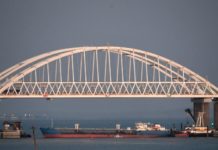Flood of the century’ fears rise in Paris along with the Seine

A police boat patrols the waters of the River Seine, whose level has risen near the statue of the Zouave at the Alma bridge in Paris on Jan. 12. (Ludovic Marin/Agence France-Presse/Getty Images)
PARIS — Is this the dreaded “flood of the century”?
After an onslaught of constant rain, Paris’s fabled Seine River has flooded — again. On Tuesday, the water level reached about 4.9 meters (about 16 feet) and is expected to peak at just over six meters (about 19.5 feet) Saturday, said Colombe Brossel, a deputy mayor of Paris. The river’s normal level is about two meters (about 6.5 feet).
For the moment, City Hall is not anticipating a full-fledged crisis, Brossel said, although emergency precautions have been put in place. River traffic has been suspended, given that certain types of boats can no longer safely pass under the Seine’s historic bridges. Starting Tuesday, the RER-C, a major commuter rail line that follows the riverbank, will be closed. The official flood emergency level is now “orange,” the second-most severe designation.
As usual, the question on the minds of many Parisians is whether this latest deluge will be the “centennial flood” that locals and meteorologists have feared for decades.
This apparently impending catastrophe has been a concern since January 1910, when — after a similar season of heavy rain — the river’s water level suddenly reached about 8.62 meters (about 28 feet) above its normal mark. Almost overnight, the city became a French Venice, its stately avenues and boulevards transformed into makeshift canals while basic infrastructure was destroyed.
 A photo taken Jan. 27, 1910, shows people on the Alma bridge in Paris as the statue of the Zouave soldier was partly submerged when the Seine rose to 8.72 meters during the “Great Flood.” (Agence France-Presse/Getty Images)
A photo taken Jan. 27, 1910, shows people on the Alma bridge in Paris as the statue of the Zouave soldier was partly submerged when the Seine rose to 8.72 meters during the “Great Flood.” (Agence France-Presse/Getty Images)
 Rue de l’Université in Paris during the 1910 flood. (Branger/Roger Viollet/Getty Images)
Rue de l’Université in Paris during the 1910 flood. (Branger/Roger Viollet/Getty Images)
At the time, the capital was entirely unprepared, and the crisis lasted two months. With the metro shut down, Parisians went about their business in boats and makeshift wooden walkways. Thousands of others were evacuated.
In the century that has elapsed, there have been some close calls, but never anything quite as severe as 1910. In 1955, for instance, the river reached 7.1 meters (about 23 feet), and 6.18 meters (about 20 feet) in 1982. Most recently, the Seine flooded in 2016 to a level of about 6.10 meters, which caused enough anxiety for the Louvre, which is on the banks of the river, to remove some of its artworks in basement storage for out-of-town safekeeping.
 A hydrographic scale on the Pont Royal in Paris during the floods on Jan. 19, 1955. (Agence France-Presse/Getty Images)
A hydrographic scale on the Pont Royal in Paris during the floods on Jan. 19, 1955. (Agence France-Presse/Getty Images)
In 2016, there were some hiccups in the city’s plan to fight the flood. The flood warning system suffered a technical failure when pieces of debris in the rising water somehow managed to block the Seine’s water-level sensors, which meant that they were actually underreporting the levels for a time.
Sebastien Maire, Paris’s chief resilience officer, could not immediately be reached to comment on the current situation. In an era of increased climate change — with global temperatures on the rise — Brossel said that the city expects these abnormal events to become more common. Despite the 2016 flood, she said, “we learned from that experience.”
In general, Parisians measure how bad things are based on how much of the “Zouave” is in the water.
 The Zouave statue, which serves as a measuring instrument for water levels during flooding of the Seine in Paris, on June 2, 2016. (Markus Schreiber/AP)
The Zouave statue, which serves as a measuring instrument for water levels during flooding of the Seine in Paris, on June 2, 2016. (Markus Schreiber/AP)










